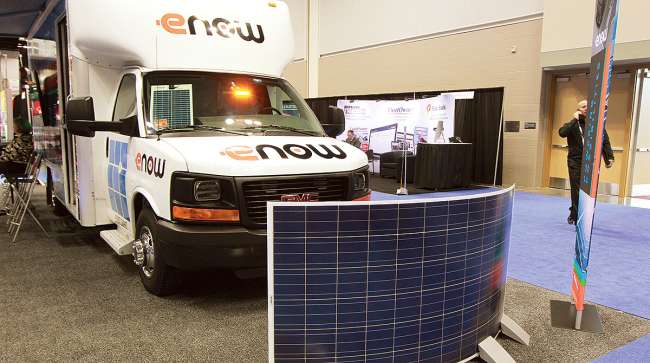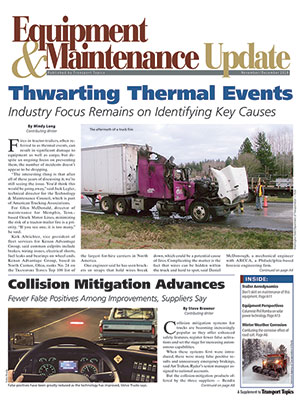Here Comes the Sun

As truck makers prepare to test and introduce Class 8 battery-electric and hydrogen-electric trucks in the next 12 to 24 months, one must wonder why only a very small number of truck operators have adopted clean solar technology.
While solar energy cannot power a Class 8 truck, it can supplement the charging capacity needed for some tractor and trailer accessories. The additional charging capacity has prolonged battery life while reducing operating and maintenance costs.
Applications of solar power on tractors and trailers turn solar energy into electrical energy to charge batteries used for liftgates, as well as cab and sleeper heating and air conditioning. Fleets report that solar systems have virtually no maintenance requirements.

Romba
Darry Stuart, president and CEO of DWS Fleet Management Services, based in Wrentham, Mass., said today’s Class 8 trucks do not have enough battery capacity and lack sufficient charging systems to fully recharge batteries. Solar battery chargers provide needed additional charging capacity.
Repeatedly draining batteries and not fully recharging them leads to premature battery failure. “It’s like a rubber band,” Stuart said. “Each time you pull and release it, it gets weaker.”
C&S Wholesale Grocers in Keene, N.H., implemented 100-watt solar charging systems on 75 trailers with liftgates in 2014. Christopher Trajkovski, vice president of transportation for fleet maintenance and assets, said the company had to address liftgate battery reliability and performance in urban delivery applications with low drive cycles.
“The key deliverable for us has been increased reliability, decreased road calls and the driver’s ability to complete liftgate deliveries on time,” said Trajkovski. “Decreased battery replacements in liftgate trailers has also occurred.”
Gerry Mead, executive director of innovation for Phillips Industries, confirmed that solar charging reduces operating and maintenance costs. Previously, Mead was vice president of maintenance at Chattanooga, Tenn.-based U.S. Xpress, where he oversaw a three-year test of 300-watt solar panel charging systems on 10 tractors.
The fleet saw “both the tractor and HVAC auxiliary battery banks were kept at a high rate of charge, especially during times of high hotel loads and air conditioning use in the sleeper berth,” Mead said.

- Collision Mitigation Advances
- Thwarting Thermal Events
- Here Comes the Sun
- The Analytical Dilemma
- Preventive Maintenance Helps Stop Rust Due to Road Salt
- Investigating Thermal Event Causes Is Crucial, Experts Say
- Tire Monitoring and Inflation Systems Can Lead to Fuel Savings, Longer Tire Life
- Seeking Alternative Solutions to Salt
- Don't Skirt Proper Maintenance on Trailer Aero Devices, Experts Say
According to Mead, the in-cab temperature remained below 75 degrees and usually below 70 degrees throughout a 10-hour rest period when the ambient temperature was more than 100 degrees. Also, solar-equipped tractors did not need any battery replacements or road calls for jump-starts.
One supplier of solar panel battery charging systems, eNow, said it has delivered more than 5,000 systems used for liftgates or in-cab HVAC. Jeffrey Flath, the company’s CEO, said liftgates are installed on 40,000 to 50,000 trucks and trailers annually. Market research firm MacKay & Co. estimated that 43% of the 3.4 million Class 8 tractors currently in operation are equipped with sleepers.
That’s a sizable market for eNow, as well as Thermo King and Carrier Transicold, two other companies that offer solar charging products to supplement a truck’s charging capacity.
The solar panel charging system, eNow said, comprises 1/8-inch-thick, plastic solar panels attached to the roof of a tractor or trailer, a charge controller and wiring harness. It works automatically when the sun rises by providing a bulk charge to replenish batteries. The panels can be attached to a roof fairing on a tractor.
Royal Jones, CEO of Mesilla Valley Transportation in Las Cruces, N.M., is a big fan of solar battery charging for tractors equipped with electric auxiliary power units. The 300-watt system helps the fleet save three gallons of fuel each day with sleeper trucks due to reduced engine idling, longer auxiliary power unit operation during driver rest breaks and longer battery life.
“Solar has extended battery life tremendously as the battery is always receiving a trickle charge,” Jones said. “During initial tests, battery life increased from six months to two years, and the alternator should last longer, but I don’t have numbers on it yet.”
Mesilla Valley Transportation ranks No. 72 on the Transport Topics Top 100 list of the largest for-hire carriers in North America.
Similar to Stuart, Trajkovski and Jones, Mead’s approach to fleet maintenance is to find advantages using new equipment or systems.
“Understanding the issues plaguing the industry and coupling them with possible fixes is a key component of a trucking management job,” Mead said. “With the lack of drivers as well as their demand for an RV-type environment in the sleeper berth of their truck, it was a no-brainer to take a look at the potentials of solar (charging).”
I couldn’t agree more.
Phil Romba has covered trucks and maintenance as a full-time journalist and worked as a public relations manager for Volvo Trucks North America during his 20-year-plus career.




